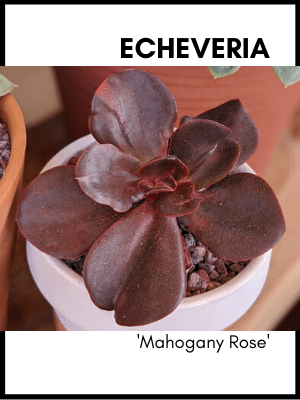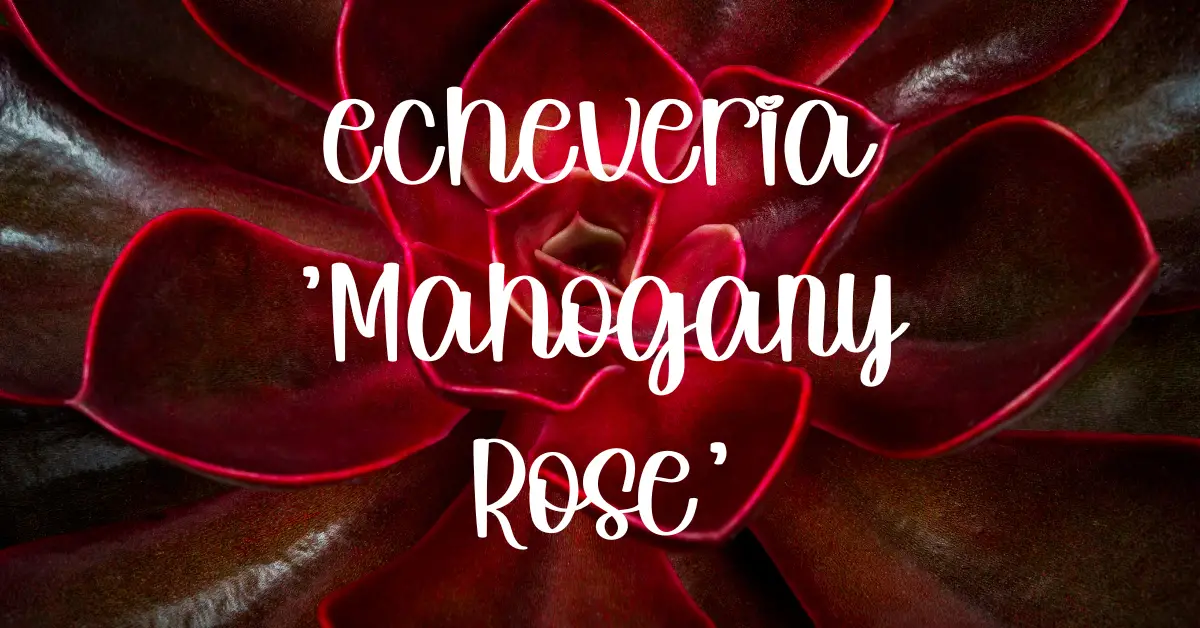Echeveria ‘Mahogany Rose’ is a beautiful succulent with rosettes of dark red, mahogany-colored leaves. The leaves have a powdery coating and can have reddish edges. In the summer, the plant produces coral-pink, bell-shaped flowers on tall stems. This succulent has a compact, rosette growth habit and can grow up to 6 inches tall and 8 inches wide.

Native Habitat/Origin
Echeveria ‘Mahogany Rose’ is a stunning Dick Wright hybrid succulent that is a cross between Echeveria shaviana and Echeveria pulidonis. This gorgeous plant is a native of California, but it is not found in the wild, as it is a hybrid species. Despite not having a specific native habitat, the plant has inherited its characteristics from its parent species, including its growth habit, leaf shape, and color.
This beautiful succulent has vibrant, mahogany-colored leaves that are tinged with shades of pink and green. Its leaves are arranged in a rosette formation, with each leaf having a pointed tip and a slightly wavy edge. The rosette can grow up to six inches wide, making it an ideal choice for a container garden or as a statement piece in any landscape.
While Echeveria ‘Mahogany Rose’ does not have a native habitat, it can thrive in a variety of growing conditions. This plant prefers bright, indirect sunlight and well-draining soil. It can tolerate drought and is well-suited to dry, arid environments. With the right care, this hybrid succulent can flourish and provide years of enjoyment.
How to Water & Fertilize
Proper watering is essential for the health and longevity of Echeveria ‘Mahogany Rose.’ This hybrid succulent prefers to be watered deeply but infrequently. Watering too often can lead to overwatering and root rot, which can ultimately kill the plant. To ensure the best results, allow the soil to dry out completely between waterings. This can be tested by sticking your finger into the soil to see if it is dry at least two inches deep.
Good drainage is also crucial for the plant’s health. If the soil does not drain well, it can lead to waterlogged roots, which can ultimately lead to rot. To ensure proper drainage, use a well-draining soil mix that contains a mix of soil amendments such as turface, pumice, perlite, and coarse sand. Terracotta pots are also recommended, as they allow for better airflow and drainage compared to plastic pots.
In terms of fertilization, Echeveria ‘Mahogany Rose’ benefits from regular feeding during the growing season. Fertilize the plant once a month using a balanced fertilizer diluted to half strength. Avoid fertilizing the plant during the winter months when it is dormant, as this can cause stress and harm to the plant. With proper watering and fertilization, Echeveria ‘Mahogany Rose’ can thrive and continue to produce its stunning blooms for years to come.
Soil
The soil is an essential factor for the growth and health of Echeveria ‘Mahogany Rose.’ This succulent prefers soil that is well-draining and has excellent airflow. A well-draining soil mix can be achieved by using a combination of regular potting soil and inorganic matter such as pumice, perlite, or coarse sand. These soil amendments help to break up the soil and provide space for air and water to flow through, allowing the roots to breathe.
Another soil amendment that can be added to the mix is Turface, which is a clay-based material that is commonly used for soil conditioning. It helps to improve drainage and aeration, which are essential for succulent plants like Echeveria ‘Mahogany Rose.’
Terracotta pots are recommended for growing Echeveria ‘Mahogany Rose’ as they allow for better airflow and drainage compared to plastic pots. The porous nature of terracotta allows the soil to dry out more quickly, which helps to prevent overwatering and root rot. Additionally, terracotta pots are heavy and stable, which helps to prevent the plant from toppling over as it grows.
Overall, using a well-draining soil mix and a terracotta pot can greatly benefit the health and growth of Echeveria ‘Mahogany Rose.’ Providing the right soil conditions can help ensure that the plant thrives and produces its stunning blooms for years to come.
How to Propagate Echeveria ‘Mahogany Rose’
Propagating Echeveria ‘Mahogany Rose’ is relatively easy and can be done using two methods – stem cuttings and offsets.
To propagate using stem cuttings, choose a healthy stem from the mother plant and make a clean cut using a sharp, sterile knife or scissors. Allow the cutting to dry out for a day or two, then dip the cut end in rooting hormone powder before planting it in well-draining soil. Water the cutting sparingly and keep it in a bright, warm spot out of direct sunlight. Roots should start to grow within a few weeks, and once the cutting has established a root system, it can be potted up in its own container.
Another way to propagate Echeveria ‘Mahogany Rose’ is by removing offsets, which are the small plants that grow around the base of the mother plant. Gently remove the offset from the mother plant by pulling it away or cutting it off with a clean, sharp knife. Allow the offset to dry out for a day or two, then plant it in well-draining soil. Water the offset sparingly and keep it in a bright, warm spot out of direct sunlight. As the plant grows, it can be potted up into a larger container.
Both of these methods of propagation can be successful with proper care and attention. With a little bit of patience, you can easily create a whole collection of Echeveria ‘Mahogany Rose’ plants to enjoy.
Light
Echeveria ‘Mahogany Rose’ needs plenty of bright, indirect sunlight to thrive, but it is also important to protect it from too much direct sunlight, which can cause the leaves to scorch. If the plant does not receive enough light, it may become leggy and its rosette may elongate. Ideally, the plant should be placed near a south-facing window where it can receive bright light for at least six hours a day. In areas with intense sunlight or high temperatures, the plant should be placed in a partially shaded location to protect it from the direct afternoon sun.
If the plant is not getting enough light, its growth may slow down, the rich red color will turn green, and it may not produce as many flowers as it would under optimal conditions. On the other hand, if the plant is exposed to too much direct sunlight, its leaves may turn yellow, white, or brown and eventually die. Therefore, it is essential to monitor the amount of light that the plant receives and adjust its location as needed to ensure that it is getting the right amount of light.
Hardiness Zone & Temperature
Echeveria ‘Mahogany Rose’ is hardy in USDA zones 9-11 and can tolerate temperatures down to 25°F (-4°C). It is best to protect this succulent from freezing temperatures and frost.
Common Pests, Problems & Solutions
Echeveria ‘Mahogany Rose’ is susceptible to mealybugs, scale, and spider mites. To control these pests, wipe down the leaves with a damp cloth or use a solution of neem oil and water. Overwatering can cause root rot, while underwatering can cause the leaves to become shriveled and dry. Make sure to check the soil moisture level regularly and adjust your watering schedule accordingly.
Is it poisonous or toxic?
Echeveria ‘Mahogany Rose’ is not toxic to humans or pets.
Growing Season:
Summer
Dormant Season:
Winter
Hardy to USDA Zone: 10a- Size: Over 8″ wide
- Foliage: Red
- Flower: Red/Orange
Propagation: Stem cuttings, leaves, seed, offsets
Light: Full sun, bright shade
Water: Drench & Dry
Soil: Gritty, mostly inorganic, quickly draining- Origin: Dick Wright hybrid, 1963

